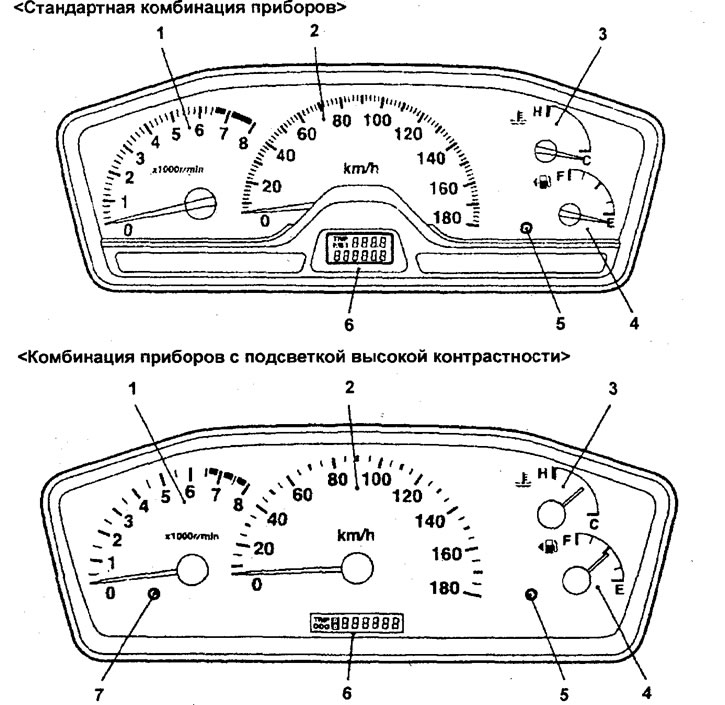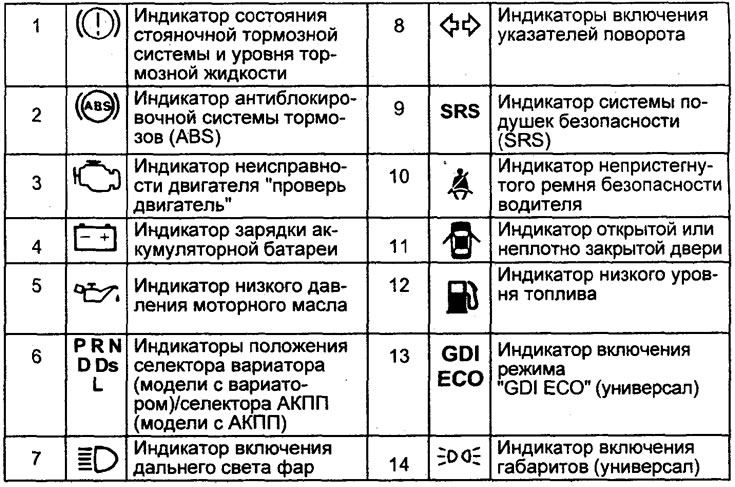Note: the indicator number in the table corresponds to the item number.
1. Parking brake status indicator and brake fluid level indicator.
A) The indicator lights up if:
- the parking brake is on;
- low level of brake fluid or the tightness of the vacuum brake booster is broken;
- the indicator circuit is faulty.
b) If the indicator lights up while driving, slow down, pull off the road and carefully stop the car. You can slow down by braking the engine and applying the parking brake, but be sure to depress the brake pedal to turn on the brake lights to alert drivers behind you to brake.
Check the parking brake, it may be on. If the parking brake is released and the indicator is on after the parking brake is released, there is a problem with the brake system. Check the brake fluid level in the reservoir.
- If the brake fluid level is low, have the vehicle's braking performance checked in a safe place. If you think the brakes are still working well enough, carefully drive the car to the nearest repair shop. If the brakes do not work, the vehicle must be towed or towed for repair.
Attention: driving a car with a low level of brake fluid is dangerous.
- If the brake fluid level is normal, then the brake booster may not be working effectively or the indicator circuit may be faulty.
2. Anti-lock brake indicator (ABS).
After turning on the ignition, the indicator lights up for a few seconds and then goes out. If the indicator lights up while driving, or the indicator does not light up, or does not go out when the engine is turned on, there may be a malfunction in the anti-lock system. Anti-lock braking system (ABS) turns on when the vehicle speed exceeds 10 km/h and turns off when the vehicle speed falls below 5 km/h.
Caution: Pressing the brake pedal repeatedly may turn on the indicator for a few seconds.
3. Engine malfunction indicator "check the engine".
The indicator lights up when the ignition key is turned to the "0N" for a few seconds and then goes out, informing the driver that the engine management system is being checked. If the indicator stays on or lights up while driving, this indicates a malfunction in the electronic engine control system.
In this case, it is necessary to move to the place of repair and diagnose the engine control system.
4. Battery charging indicator.
A) The indicator lights up when the ignition key is turned to the "ON" and should go out after the engine is started.
b) If the indicator lights up while driving, the charging system is faulty or the (broken off) generator drive belt. However, the engine will continue to run until the battery is completely discharged. Turn off optional equipment (air conditioning, fan, radio, etc.) and move to the place of repair.
5. Low engine oil pressure indicator.
A) The indicator lights up when the ignition key is turned to the "ON" and should go out after the engine is started.
b) The indicator lights up if the engine oil pressure is too low.
V) If the indicator flashes or lights up while driving, pull over to the side of the road and turn off the ignition.
- The indicator may flash after hard braking or when the engine is idling. There is no malfunction if the indicator goes out with a slight increase in engine speed.
- The indicator may come on when the engine oil level is too low. But this indicator is not designed to inform you about a low oil level, so periodically check the level with a dipstick.

Instrument combination. 1 - tachometer, 2 - speedometer, 3 - coolant temperature gauge, 4 - fuel gauge, 5 - toggle and reset trip meters to zero button, 6 - odometer/ trip meters, 7 - high contrast backlight switch.
Table. Instrument cluster indicators.

6. CVT selector position indicators ("R", "R", "N", "D", "Ds" or "L") or automatic transmission selector position indicators ("R", "R", "N", "D" or "Ds").
When the selector is moved to any position on the instrument cluster, the indicator corresponding to the selected position of the variator selector / automatic transmission selector lights up.
7. The high beam indicator lights up when the high beam headlights are on.
8. Turn signal indicators. The indicators flash when the direction indicators or alarms are turned on. Too fast flashing of the indicators indicates a bad connection in the direction indicator circuit or a failure of the direction indicator lamp.
9. Airbag indicator (SRS).
The indicators come on when the ignition switch is in the "ON" or "ACC". After a few seconds, the indicators will turn off. If the indicators do not light up or light up while driving, there is a malfunction in the SRS system components.
10. Driver's seat belt not fastened indicator.
The indicator lights up when the ignition is turned on for a few seconds, and then goes out. If the driver is not wearing a seat belt, the indicator on the instrument cluster will flash continuously.
11. Indicator of an open or loosely closed door.
The indicator stays on until all doors are tightly closed.
12. Low fuel level indicator. The indicator comes on when the ignition key is in the "ON", and the amount of fuel in the tank is less than 8 liters. On slopes or when cornering, the indicator may come on due to fluctuations in the fuel in the tank. Attention: do not drive with a very low level of fuel in the tank. Running out of fuel can damage the catalytic converter.
13. Mode enable indicator "GDI ECO" Illuminates when the engine is running on an extra lean air/fuel mixture (the most economical mode of engine operation when idling, when driving at a constant speed, decelerating or smoothly accelerating).
14. The indicator of inclusion of dimensions lights up at inclusion of dimensions.
